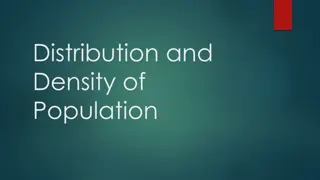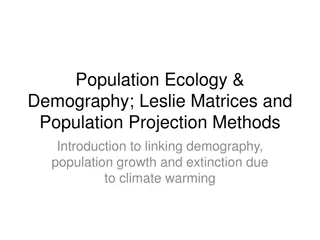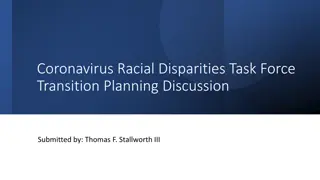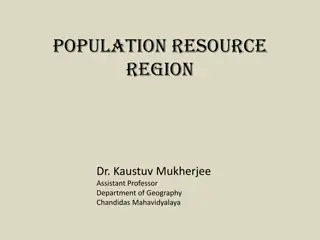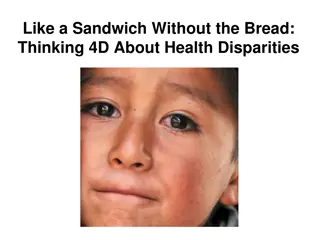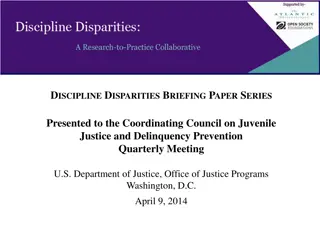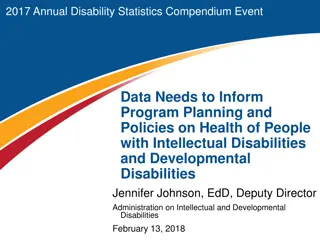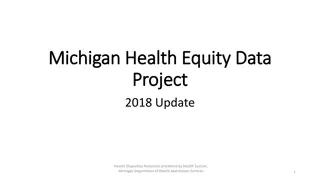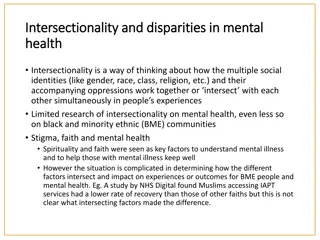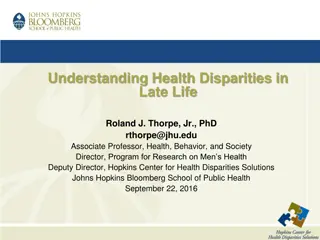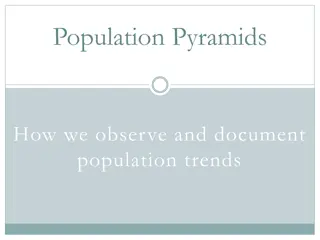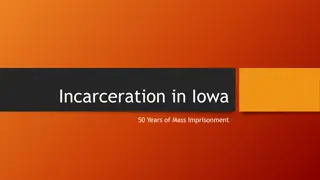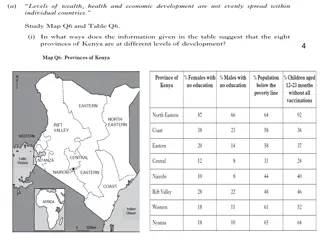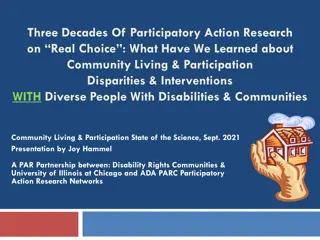Overview of the South African National Population Register
The South African National Population Register (NPR) is a vital system maintained by the Department of Home Affairs. It serves to record and update information on the country's resident population, issue identity documents, and handle related administrative tasks. The NPR has evolved over the years
2 views • 16 slides
Addressing Oral Health Disparities in School Communities
This resource highlights the importance of improving pediatric oral health outcomes in schools through community partnerships. It discusses the existing disparities, barriers to accessing dental care, and the impact of oral health on educational outcomes. The learning outcomes include identifying di
2 views • 19 slides
Addressing Racial Disparities in Hematology: Insights and Strategies
Health equity in hematology is a critical focus area, highlighted in a press briefing with panelists discussing interventions to mitigate disparities in leukemia outcomes based on race, gender, and mental health status. Research confirms historical disparities in acute myeloid leukemia outcomes for
4 views • 33 slides
Distribution and Density of Population.
Population distribution and density are closely related concepts that describe the spatial patterns and proportional relationships of human populations across the world. Factors such as physical landscapes, socio-cultural influences, and demographic trends contribute to the regional disparities in p
9 views • 9 slides
Addressing Racial/Ethnic Disparities in Addiction Research
Research by Dr. LaTrice Montgomery and colleagues highlights the racial/ethnic disparities in addiction prevalence, treatment outcomes, and social impact. Studies show differences in opioid overdose deaths among adults, economic burdens of health inequities, and race moderation effects in clinical t
0 views • 24 slides
Understanding Health Disparities and Equity in Behavioral Health Care
This module explores the significance of health disparities, health equity, and social justice within integrated behavioral health care. It delves into the role of addressing disparities, promotes ways to achieve equity in care models, and discusses the key organizations dealing with health disparit
0 views • 28 slides
Understanding Population Ecology and Demography Through Leslie Matrices
Explore the critical aspects of population ecology and demography, focusing on factors influencing abundance, population growth, regulation, and the impacts of climate change. Learn about population projections, growth models, age-structured populations, and data requirements for estimating populati
4 views • 35 slides
Impact of Human Population Growth on Environment and Welfare
The rapid growth of the human population is placing immense pressure on the environment, leading to increased demand for resources like food, water, and shelter. The effects of human activity on the environment have escalated significantly over the years due to population expansion. High birth rates
0 views • 8 slides
Introduction to Sampling in Statistics
Sampling in statistics involves selecting a subset of individuals from a population to gather information, as it is often impractical to study the entire population. This method helps in estimating population characteristics, although it comes with inherent sampling errors. Parameters represent popu
2 views • 24 slides
Addressing Racial Health Disparities: Transforming the Task Force Efforts
Comprehensive report and action plan submitted by Thomas F. Stallworth III, outlining the objectives, accomplishments, and ongoing initiatives of the Coronavirus Racial Disparities Task Force. The report includes engaging departments and stakeholders, listing achievements post-interim report, contin
0 views • 9 slides
Understanding Population-Resource-Region Relationship: A Geographical Perspective
Explore the intricate relationship between population, resources, and regions through a geographical lens. Delve into classifications based on population, resources, and technology, with examples from different countries and regions. Discover the concepts of optimum population, over-population, and
1 views • 11 slides
Understanding Demography: Population Trends and Analysis
Demography is the study of population size, distribution, and composition, encompassing elements such as mortality, natality, migration, and demographic forces. Population census plays a crucial role in collecting and analyzing demographic data, with methods like De Jure and De Facto census. Inter-c
6 views • 21 slides
Health and Health Care for American Indians and Alaska Natives in the United States
American Indians and Alaska Natives (AIANs) in the United States face unique health challenges, with disparities in health outcomes compared to Whites. Despite the services provided by the Indian Health Service (IHS), AIANs continue to experience poorer health status. The population accounts for 2%
5 views • 8 slides
Understanding Health Disparities and Medicaid's Role in Advancing Equity
Health and health care disparities refer to differences in health outcomes and access to care among different groups, often linked to social, economic, and environmental inequities. People of color face longstanding disparities in health and health care, with factors inside and outside the health ca
5 views • 16 slides
Exploring Health Disparities in 4D: A Multidimensional Perspective
This presentation delves into the complexities of health disparities, particularly focusing on racial and ethnic differences in healthcare quality. It discusses factors such as implicit bias, cultural competence, and social determinants that contribute to unequal treatment in medical settings. The s
0 views • 18 slides
Understanding Regional Disparities: Causes and Impacts in India
Regional disparities in India are evident through differences in income, education, health services, and industrialization levels among regions. Historical, geographical, economic, and governance factors contribute to these disparities, impacting overall economic growth. Measures such as analyzing p
0 views • 12 slides
Health and Health Care Disparities for Black Americans in the United States
Analysis of health and health care disparities for Black Americans in the US reveals significant challenges, including underrepresentation, economic disparities, and health outcome gaps. Despite improvements in some health measures, such as HIV diagnosis rates and teen birth rates, Black Americans s
5 views • 9 slides
Understanding Cancer Health Disparities and Initiatives
Exploring the concept of cancer health disparities, this content touches on the National Cancer Act of 1971, the impact of social determinants of health, and various initiatives such as the National Minority Cancer Awareness Week. It highlights efforts to reduce disparities through research, advocac
6 views • 8 slides
Exploring Ethnic Disparities in Various Aspects of Society
This content delves into the racial disparities in crime, justice, education, health, housing, and employment. It emphasizes the importance of looking beyond national averages to understand the nuanced challenges faced by different ethnic groups in society. The visuals presented highlight varying ou
0 views • 17 slides
OECD Expert Group on Disparities in National Accounts Work Summary
The OECD Expert Group on Disparities in National Accounts focuses on developing methodology to produce distributional results for household income, consumption, and saving. Their work involves adjusting national accounts totals, identifying relevant variables from micro data sources, imputing missin
0 views • 15 slides
Addressing Discipline Disparities in School Systems
Systemic disparities in school discipline pose critical short- and long-term consequences for students, schools, communities, and economies. Efforts to address these disparities include recent national initiatives, federal guidance, and collaborative research projects aiming to improve interventions
1 views • 7 slides
Understanding the Health Disparities in People with Intellectual and Developmental Disabilities
The article highlights the pressing need for better information and updated prevalence rates to inform program planning and policies on the health of individuals with intellectual and developmental disabilities (ID/DD). It discusses the challenges in understanding the health-related needs of this po
0 views • 28 slides
Improvement of Population and Vital Statistics Metadata in the Demographic Yearbook System
The Demographic Yearbook system focuses on enhancing population and vital statistics metadata to ensure accurate and concise reflection of population concepts across 230+ countries. It involves annual collection of official national population estimates, vital statistics, and UN international travel
0 views • 16 slides
Challenges and Disparities in Minority Health and Workforce
The content discusses the challenges faced by minorities in health care settings, focusing on the impact of COVID-19 and disparities within the workforce. It highlights the importance of addressing social determinants of health, such as economic inequalities and racial disparities, to ensure holisti
0 views • 7 slides
Understanding Logistic Growth in Population Dynamics
Explore the logistic growth equation and its applications in modeling population dynamics. Dive into the concept of sigmoidal growth curves and the logistic model, which reflects population growth with limits. Learn how to calculate population change using the logistic growth equation and understand
0 views • 26 slides
Addressing Health Disparities in People with Intellectual Disabilities: Roles of Nurses and Midwives
People with intellectual disabilities face significant health disparities, including multiple long-term health conditions and higher mortality rates. Nurses and midwives play diverse roles in addressing these disparities through research and inclusive practices. Common conditions include epilepsy, o
0 views • 20 slides
Overview of Population Measures and District Data from Census Reports
The census reports various population measures including total population, voting age population, and citizen voting age population. The data includes breakdowns by ethnicity for each trustee district. Changes in voting and citizen voting age population percentages are also provided. Data is sourced
0 views • 4 slides
Addressing Disparities in School Discipline: Understanding Implicit Bias and Cultural Competence
This content delves into the intricate issues surrounding implicit bias and cultural competence in school discipline, focusing on disparities related to race, disability, gender, gender identity, and sexual orientation. It discusses the factors contributing to disproportionate disciplinary actions,
0 views • 5 slides
Michigan Health Equity Data Project Update 2018
The Michigan Health Equity Data Project 2018 Update focuses on reducing health disparities and improving minority health in Michigan. The Michigan Department of Health and Human Services presents recommendations through the Michigan Health Equity Roadmap to address key issues related to health inequ
0 views • 66 slides
Importance of Measuring Race and Ethnicity in Health Disparities
This presentation discusses the significance of measuring race and ethnicity in addressing health disparities, underlining the impact of social, economic, and environmental factors on various demographic groups. It covers federal data collection guidelines, best practices, and the use of demographic
0 views • 14 slides
Intersectionality and Disparities in Mental Health: Understanding the Complex Interplay
Intersectionality, with its focus on the interconnected nature of social identities and oppressions, plays a critical role in mental health disparities, especially among Black and Minority Ethnic communities. Factors such as stigma, faith, gender, race, and migration intersect to influence mental he
0 views • 4 slides
Understanding Health Disparities in Late Life by Roland J. Thorpe, Jr., PhD
The presentation by Roland J. Thorpe, Jr., PhD focuses on health disparities in late life, highlighting projections of the resident population by race/ethnicity, the expected increase in the older U.S. population from 1990 to 2050, and percentages of males and females aged 65 and over with disabilit
0 views • 11 slides
Understanding Population Pyramids for Analyzing Population Trends
Population pyramids are graphical illustrations that showcase the distribution of age groups within a population, segmented by gender. By observing and documenting the patterns of population pyramids, one can discern trends such as rapid growth, slow growth, or negative growth, which are influenced
0 views • 7 slides
Understanding Racial and Ethnic Income Disparities
This piece delves into the income and wealth gaps among different racial and ethnic groups, emphasizing the importance of framing when analyzing such disparities. It presents data from the Federal Reserve's Survey of Consumer Finances, highlighting the slower closure of income gaps for Black and His
0 views • 16 slides
Approaches to Health Disparities in Anthropology: Quantitative vs. Qualitative Methods
Exploring health in anthropology involves various factors like social, cultural, biological, and linguistic influences. This content delves into the quantitative research on disparities in health insurance coverage, particularly focusing on Latino vs. white respondents in Texas. The study utilized l
0 views • 13 slides
Racial Disparities in Iowa's Criminal Justice System: A Deep Dive
Examine the stark racial disparities in Iowa's criminal justice system, spanning from incarceration rates to felony and misdemeanor convictions. Despite slightly lower per capita incarceration rates compared to the national average, Iowa faces significant challenges in addressing the overrepresentat
0 views • 10 slides
Maine Workforce and Population Trends Analysis 2014-2024
Maine's workforce and population outlook from 2014 to 2024 reveals a decline in births, resulting in an aging population and workforce imbalance. The state faces challenges due to low birth rates, negative natural population change, and minimal net migration, impacting labor force growth and total p
0 views • 31 slides
Regional Development Disparities in Kenya, India, and Other Countries
The provided content discusses the disparities in development indicators across different regions, focusing on Kenya, India, and other countries. It highlights significant differences in education, wealth, and health outcomes, showcasing how certain regions are more developed than others based on sp
0 views • 25 slides
The Global Human Population Explosion: Causes and Implications
The lecture explores the rapid increase in the global human population post-World War II, analyzing factors such as birth rates, mortality rates, and life expectancy. Various counterarguments are presented, including the debate on population growth benefits, ethical concerns over reproductive interf
0 views • 20 slides
Decades of Participatory Action Research on Community Living and Participation Disparities
Explore the insights gained from three decades of participatory action research on real choice, community living, and participation disparities among diverse people with disabilities. The initiatives focus on multifaceted interventions aimed at promoting community living and participation, with a sp
0 views • 14 slides



